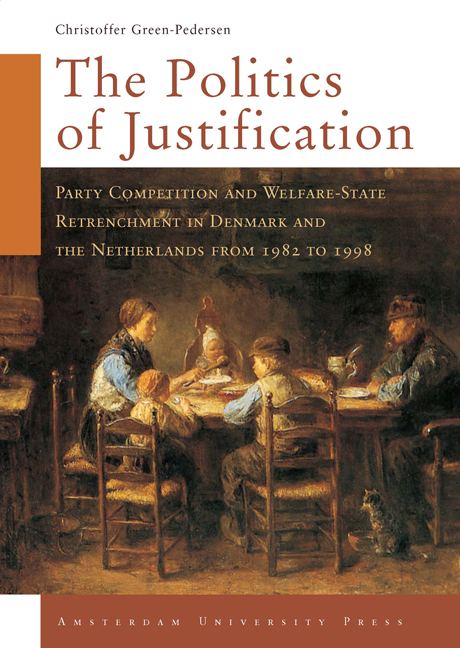 The Politics of Justification
The Politics of Justification Book contents
- Frontmatter
- Acknowledgments
- Contents
- List of Abbreviations
- 1 Introduction
- 2 From Theories of Expansion to Theories of Retrenchment
- 3 Framework for Government Choice on Retrenchment
- 4 Research Strategy and Research Design
- 5 Retrenchments in Denmark and the Netherlands
- 6 Dutch Politics and Welfare-State Retrenchment.How Party Competition Produced Consensus
- 7 Danish Politics and Welfare-State Retrenchment:The Difficulties of a Right-Wing Government and the Possibilities of a Left-Wing Government
- 8 The Evidence on Balance and some Quibbles
- 9 Party Politics Matter – Summary and Implications
- Appendix
- Summary
- Notes
- References
- Index
- Frontmatter
- Acknowledgments
- Contents
- List of Abbreviations
- 1 Introduction
- 2 From Theories of Expansion to Theories of Retrenchment
- 3 Framework for Government Choice on Retrenchment
- 4 Research Strategy and Research Design
- 5 Retrenchments in Denmark and the Netherlands
- 6 Dutch Politics and Welfare-State Retrenchment.How Party Competition Produced Consensus
- 7 Danish Politics and Welfare-State Retrenchment:The Difficulties of a Right-Wing Government and the Possibilities of a Left-Wing Government
- 8 The Evidence on Balance and some Quibbles
- 9 Party Politics Matter – Summary and Implications
- Appendix
- Summary
- Notes
- References
- Index
Summary
This book is an investigation of retrenchment in Denmark and in the Netherlands during the period 1982 to 1998, focussing on retrenchment of old-age pensions, unemployment benefits and disability pensions/early- retirement benefits. The general aim of the book is to contribute to the scholarly debate about welfare-state retrenchment in a number of ways. The main aim is to add to the knowledge of the factors causing variation in retrenchment between countries and across social-security schemes. Here, the argument of the book is that politics is the main factor causing variation. In this way, the book differs from most other writings on retrenchment that follow the new institutional wave within political science in general, highlighting the role of institutional factors. An additional aim of the book is to add to the empirical knowledge about retrenchment. As argued by Alber (1996: 3), ‘… systematic studies of retrenchment processes in a comparative perspective are still thoroughly missing.’ This book aims at filling a small part of that vacuum.
However, this book should not only interest scholars engaged in the debate about welfare-state retrenchment. Welfare-state retrenchment is part of the broader effort of Western governments to adjust their models of welfare capitalism to a new economic environment. Welfare-state retrenchments are probably the most controversial part of this effort, and this book therefore contributes to the understanding of different country's capacity to adjust their models of welfare capitalism. Further, Denmark and the Netherlands have come to be seen as two of the success stories with regard to this adjustment process. Scholars are thus debating both a Dutch and a Danish miracle (cf. Visser & Hemerijck 1997; Schwartz 2001; Green-Pedersen 2001). The book draws attention to the role that party politics has played in the adjustment processes within the two countries. This includes both the development of the party systems in the two countries and the situation of the Social Democratic Parties. The discussion of the latter factor also contributes to the wider debate about the dilemmas of European Social Democracy.
- Type
- Chapter
- Information
- The Politics of JustificationParty Competition and Welfare-State Retrenchment in Denmark and the Netherlands from 1982 to 1998, pp. 159 - 164Publisher: Amsterdam University PressPrint publication year: 2002
